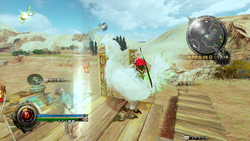
Clock, under the minimap in the top right hand corner, showing current time in Lightning Returns.
The day and night cycle is a recurring feature in the Final Fantasy series. It features an ongoing time cycling the day and night, rather than the time of day being strictly controlled by the plot, remaining constant until the player progresses in the story. Typically, each location has different musical themes for different times of day, and the specific location's battle theme may change as well. The effect can be merely visual, but in some games certain tasks and monsters can only be undertaken during a specific time in the cycle.
Template:See Also
Appearances
Final Fantasy XI
Template:Sideicon Although the game is technically set in 884 C.E. and as far as the story goes time does not actually flow, the day and night cycle features prominently and can be checked using the /clock command. This affects a number of gameplay aspects, including the appearance of certain monsters (especially the undead) at certain times of day, shop opening times, as well as specific time windows for completing certain quests. Many quests and missions require the players to return the next in-game day to proceed.
Final Fantasy XI runs under a 60 minute per hour, 24 hour day cycle, with 8 days a week, 30 days a month and 360 days in a Vana'diel year. Due to this flow of time, the game also features moon phases and seasons, which have various effects on gameplay.
Vana'diel time moves 25 times faster than Earth time: 1 Vana'diel hour is 2 minutes and 24 seconds in Earth time, and 1 Earth hour is 25 Vana'diel hours.
Lightning Returns: Final Fantasy XIII
Template:Sideicon
The day and night cycle ties closely to the game's story. Many main and side quests depend on the clock and Lightning has a limit of thirteen days to complete all main quests and collect enough Eradia to advance to the last day. The day-night cycle is not in effect during the game's prologue in Yusnaan, on the final day, or during any visit to the Ark.
There are four times of day and on each a different field and battle theme will play, although some areas are exempt from this rule:
- Morning: 6:00 - 11:59.
- Afternoon: 12:00 - 17:59.
- Evening: 18:00 - 19:59.
- Night: 20:00 - 6:00.
Final Fantasy XIV
Template:Sideicon Some types of fish can only be caught during certain hours, and the Sightseeing Log entries requires a certain time of day. The day and night cycle otherwise doesn't affect gameplay or quests (though most cutscenes will reflect the current time of day), but themes for locations change at 6 AM and 6 PM. Weather events cycle at 8:00 AM, 4:00 PM, and 12:00 AM each Eorzean day.
Final Fantasy XV
Template:Sideicon The cycle of day and night ties to which enemies will spawn on the field. Daemons emerge during the night, providing incentive for the player to camp out or seek refuge in a hotel. Some dungeons are only open at night.
The world is afflicted with the Starscourge, a plague that lengthens nights, and only the Oracle Lunafreya Nox Fleuret is preventing the world from plunging into complete darkness. The advancement of Starscourge is shown in the game by its day and night cycle. In the beginning of the game, the party wakes up from a rest at 6 AM. By Chapter 8 the party wakes up at 9 AM and the sun already starts to set after 2 PM. In Chapter 12 the party will get up at 10 AM, and Chapter 13 onwards, the player won't see sun again. Daemons spawn on the field after nightfall.

Demonstration of light effects during different times of the day posted to the official Twitter.
The day and night cycles and cloud formations are done by physical calculations, the lighting and the shadows changing as the day goes on. At night towns light up, with people turning the lights on in their homes.[1] It was decided to be made this way to have a smooth change between the cycles and to have a more dynamic lighting system, reflecting the mood of a certain region/place.
To create the flow of hours, the developers had to get as close as possible to the real world. They would take a photo of the real sun and blue skies and drop it into the game and employ a system called the Sky System to make adjustments. In the real world there is not one minute, or one second, where light is the same. The sun is 400,000 times brighter than the moon, though impossible for the human eye to detect. To get closer to that in Final Fantasy XV, the sun is set to shine more than 100,000 times brighter than the moon; the exposure is adjusted so that the lighting is always just right within the game.[2]
Final Fantasy Agito
Template:Sideicon A real-time cycle synonymous with Japan Standard Time (JST) was followed. The cycles were morning (from 04:00 to 11:00), afternoon (11:00 to 16:00), evening (16:00 to 20:00), and night (20:00 to 04:00). It influenced NPC conversations and the amount of bonding points that could be obtained when talking to the original twelve members of Class Zero. The amount of Friend Points needed at the Friend Gacha were reset daily, as the cost accumulated with each spin.
Final Fantasy: The 4 Heroes of Light
Template:Sideicon The day and night cycle changes when the player is on the world map. At nighttime, the musical themes for the overworld and the seven towns are replaced by more tranquil rearrangements, different sets of enemies appear on the overworld, and certain events become accessible, such as entry into the Guera Caverns and the mysterious whirlpool in Liberte. Sleeping at an inn returns the cycle to daytime. Day and night are omitted in the second half of the game, after defeating Rolan in Spelvia, due to the spread of darkness over the world.
Bravely Default
Template:Sideicon On the world map, day and night change depending on the cue in the music, allowing access to certain enemies and events that can only be present at nighttime, such as entry into the Grand Mill Works and the sub-scenario to obtain the Red Mage job. Background music is absent in towns at nighttime, save for Florem. Sleeping at an inn returns the cycle to daytime.
References
Template:Recurring elements
